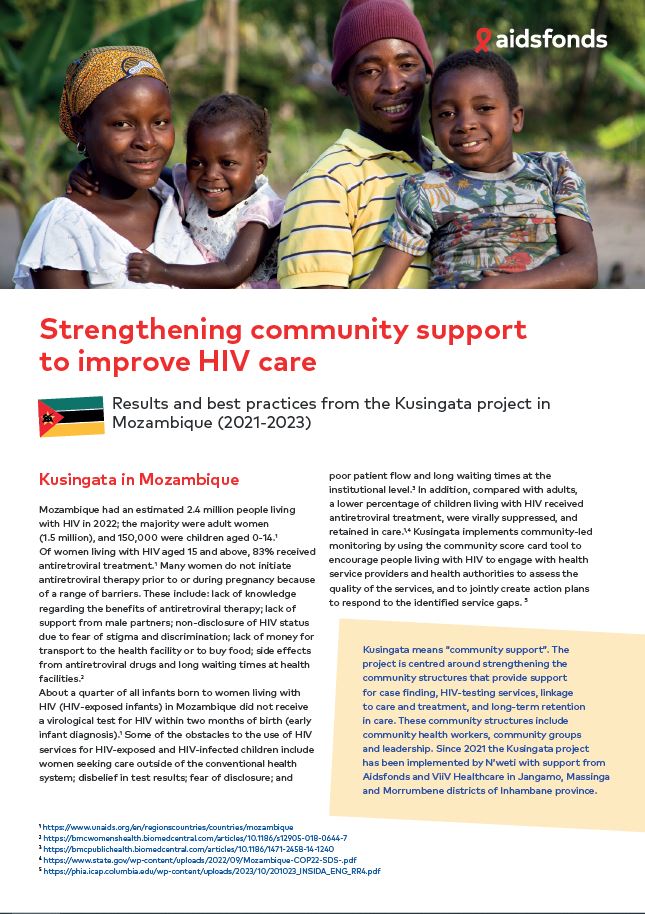Background
Mozambique had an estimated 2.4 million people living with HIV in 2022; the majority were adult women (1.5 million), and 150,000 were children aged 0-14. Of women living with HIV aged 15 and above, 83% received antiretroviral treatment. Many women do not initiate antiretroviral therapy prior to or during pregnancy because of a range of barriers. These include: lack of knowledge regarding the benefits of antiretroviral therapy; lack of support from male partners; non-disclosure of HIV status due to fear of stigma and discrimination; lack of money for transport to the health facility or to buy food; side effects from antiretroviral drugs and long waiting times at health facilities.
About a quarter of all infants born to women living with HIV in Mozambique did not receive a virological test for HIV within two months of birth (early infant diagnosis). Some of the obstacles to the use of HIV services for HIV-exposed and HIV-infected children include women seeking care outside of the conventional health system; disbelief in test results; fear of disclosure; and poor patient flow and long waiting times at the institutional level. 3 In addition, compared with adults, a lower percentage of children living with HIV received antiretroviral treatment, were virally suppressed, and retained in care.
Objectives
The Kusingata project’s goal is that “children and mothers living with HIV and/or affected by HIV in Inhambane province can live healthy lives in which they can reach their full potential”. To achieve this, the programme has the following main objectives:
- Establish an enabling environment for increased provision, demand, uptake, and ownership of quality
community-based and clinical HIV services among pregnant and breastfeeding adolescents and women, and children
living with HIV - Identify and link children, adolescents, pregnant and breastfeeding women living with HIV to care and treatment.
- Support retention in care and adherence to treatment of children, adolescents, pregnant and breastfeeding adolescents and women living with HIV, towards achieving viral suppression
- Document the results and the implementation model for advocacy and sustainability
Impact
Through the comprehensive community-based service package, the Kusingata project achieved the following results among others:
- 24 mentor mothers, 41 lay counsellors, 42 community dialogue/community-led monitoring facilitators, and 19 village savings and loan group/income generating group facilitators were trained to support people living with HIV in the communities.
- 10,477 participants (55% women) completed the seven-week community dialogue activity to sensitise and mobilise the community about HIV and prevention of vertical transmission, and to improve health-seeking behaviour. At the start of the community dialogue sessions, 51% participants responded correctly to statements about HIV; this
increased to 96% by the end. - 2,152 referrals were provided for HIV testing and 1,466 for other health services through the community dialogues and other project activities.
- 14,593 individuals (19% of them children) were tested for HIV and 1,074 (6% children) tested positive.
- 98% of those who were diagnosed as living with HIV, were successfully linked to care and treatment.
- 1,152 children and adults received home visits to improve antiretroviral treatment literacy and retention, including 382 pregnant and breastfeeding women living with HIV and 192 HIV-exposed children visited by mentor mothers.
- 179 pregnant and breastfeeding women living with HIV participated in mother-to-mother peer support groups.
About the Kids to Care Model
The Aidsfonds Kids to Care model empowers communities to strengthen the links between communities and health facilities to find, test, treat and retain children, and pregnant and lactating mothers, living with HIV. The Kids to Care model is built on the following foundational principles:
- Community-owned and community-led
- Builds on existing community structures
- Child and family centred
- Builds on government frameworks and policies
- Key stakeholders are meaningfully involved from the beginning
- Interventions are informed by data
- Committed to sustainability and long-term support
More about the Kids to Care model can be found here
Do you want to know more results and best practices from the Kusingata project in Mozambique? Download the ‘’Strengthening community support to improve HIV care’ factsheet.
What is next for the Kusingata project?
The project participants confirmed the value of providing comprehensive community-based services for vulnerable people living with HIV, including mobilisation of community support and socioeconomic strengthening activities. To measure the effect of different interventions on retention, socioeconomic status and quality of life of the beneficiaries, N’weti will continue to develop improved monitoring and evaluation models. The results will be used to identify gaps and opportunities for improvement, and to advocate for scale-up of the community-based service package. The project will also initiate new collaborative activities, such as implementing mobile testing in hard-to-reach communities together with a clinical partner that can also provide community-based antiretroviral treatment distribution and other health services. In addition, N’weti and the partners will intensify their outreach to adolescents through provision of community dialogues and health services near schools, and by training teachers to create a better understanding of paediatric HIV and how to refer adolescents for support when needed.


